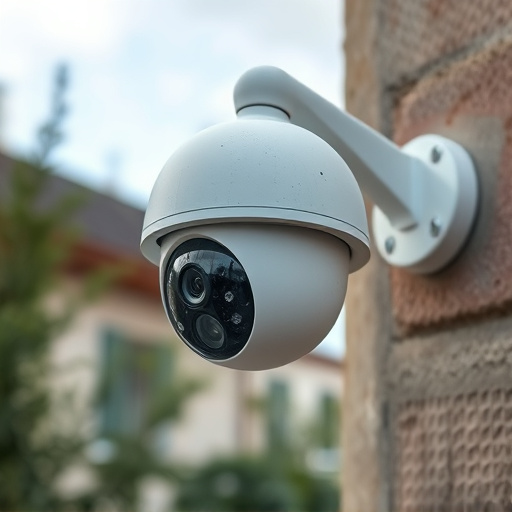Selecting the ideal height for indoor security cameras involves understanding the Indoor Fake Dome Bullet Differences. While standard models are typically 2-4 feet (0.6-1.2 meters) high, offering a balanced field of view and discreet appearance, various factors like camera angle, monitored area, and obstructions must be considered. For optimal surveillance, mount indoor dome cameras at 5-7 feet (1.5-2.1 meters) for general activity capture, adjusting to 6-8 feet (1.8-2.4 meters) for wider fields of view or 4-5 feet (1.2-1.5 meters) for lower-resolution cameras with limited angles. These adjustments cater to the Indoor Fake Dome Bullet Differences for effective surveillance tailored to each environment.
“Uncover the optimal height for your fake security cameras with our comprehensive guide. In ‘Understanding Fake Security Camera Mounting Heights’, we demystify the process, highlighting indoor vs outdoor nuances between dome and bullet cameras. Explore key factors influencing mounting decisions, from field of view to potential obstructions. Learn best practices tailored to camera types, ensuring maximum coverage. Discover the ideal heights for both indoor fake dome and bullet cameras to fortify your security system effectively.”
- Understanding Fake Security Camera Mounting Heights: A Comprehensive Overview
- Indoor vs Outdoor: Exploring the Differences in Dome and Bullet Cameras
- Factors Influencing Mounting Heights: Essential Considerations for Optimal Placement
- Best Practices for Choosing the Right Mounting Height Based on Camera Type
Understanding Fake Security Camera Mounting Heights: A Comprehensive Overview
When it comes to choosing the right height for a fake security camera, understanding the indoor fake dome bullet differences is key. These cameras, designed to mimic real surveillance equipment, have specific mounting requirements based on their type and intended use. The standard indoor fake dome bullet cameras, for instance, are typically mounted at heights ranging from 2 to 4 feet (0.6 to 1.2 meters) above the ground. This strategic placement ensures optimal field of view while maintaining a discreet appearance.
The height selection process involves considering factors like the camera’s angle of vision, the area to be monitored, and potential obstructions. For example, placing a fake security camera too high might result in an inadequate field of view or obscure important details. Conversely, mounting it too low could hinder visibility due to obstacles or create shadows that affect image quality. A comprehensive overview of indoor fake dome bullet differences and their ideal mounting heights is crucial for effective and efficient surveillance.
Indoor vs Outdoor: Exploring the Differences in Dome and Bullet Cameras
When considering fake security cameras, understanding the indoor-outdoor difference is crucial. In indoor settings, dome cameras are often the preferred choice due to their discreet and aesthetically pleasing design. These cameras blend seamlessly with interior decor, offering a non-intrusive surveillance solution for homes and offices. Their wide field of view ensures comprehensive coverage within enclosed spaces.
In contrast, outdoor security requires different considerations. Bullet cameras, designed for durability and weather resistance, are ideal for exterior installations. They provide clear images even in harsh conditions, making them a reliable option for protecting businesses, warehouses, or any outdoor areas. The robust construction accounts for varying climates, ensuring consistent surveillance performance.
Factors Influencing Mounting Heights: Essential Considerations for Optimal Placement
When determining the optimal mounting height for security cameras, several factors come into play, especially with indoor fake dome bullet cameras. Unlike their outdoor counterparts, indoor cameras have unique requirements due to environmental differences. One key consideration is the line of sight—ensuring the camera has an unobstructed view of the area to be monitored. This means positioning it high enough to avoid obstructions like furniture or decorations, which can impede the field of view.
Another influencing factor is the type of space and its layout. In open-plan offices or large rooms, a higher mounting height might be necessary to capture all areas effectively. Conversely, in smaller spaces with more intricate layouts, lower mounting heights could provide better coverage. Additionally, the Indoor Fake Dome Bullet’s design itself plays a role; different models may have varying field of vision and resolution, dictating the ideal placement for crisp, clear images and comprehensive surveillance.
Best Practices for Choosing the Right Mounting Height Based on Camera Type
When selecting the optimal mounting height for your fake security camera, consider the specific type of camera and its intended use. For indoor settings with standard fake dome bullet cameras, a mounting height of 5 to 7 feet (1.5 to 2.1 meters) above the ground is generally recommended. This placement offers a balanced view, capturing both general activity and detailed footage without appearing overly obtrusive.
Different camera types may require adjustments to this guideline. For instance, taller cameras with wider fields of view might be best mounted at 6 to 8 feet (1.8 to 2.4 meters) to ensure comprehensive coverage. Conversely, lower-resolution or indoor dome cameras with more limited angles could effectively operate at 4 to 5 feet (1.2 to 1.5 meters), providing a focused yet strategic viewpoint.
In conclusion, understanding the optimal mounting heights for security cameras, whether indoor (fake dome) or outdoor (bullet), is crucial for enhancing surveillance capabilities. By considering factors like field of view, lighting conditions, and specific camera types, you can ensure effective coverage. Remember that the right mounting height can significantly improve video quality and deter potential criminals, making your home or business safer.
